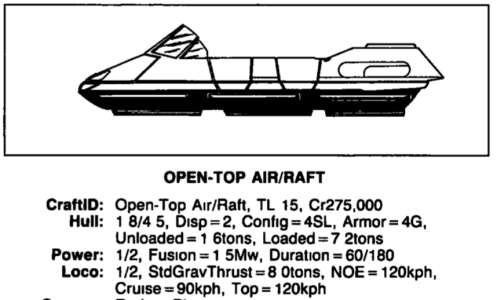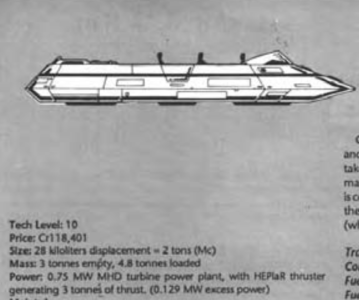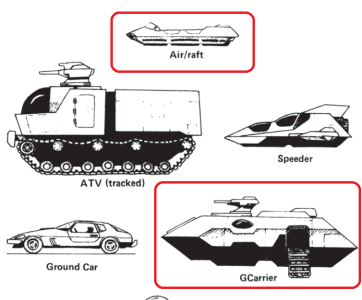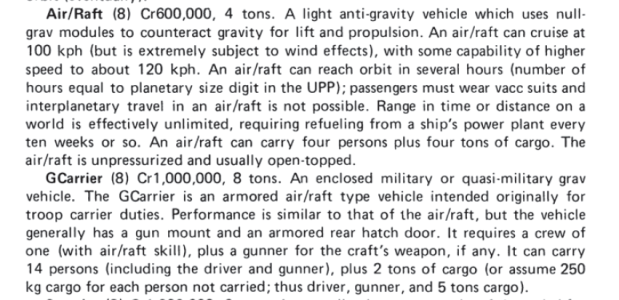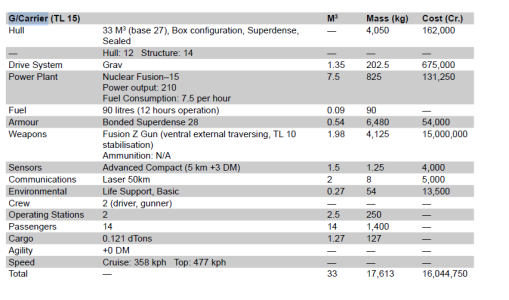Badenov
SOC-13
So, my copy of MgT1 says an air/raft requires 4 dTon, noting "The tonnage and cost covers minimal hangar space, indicating the vehicle is either carried on the outer hull or in a formfitting compartment on board."
High Guard says "Normally, when a small craft is included in the design of a larger one, it is installed into a form–fitting enclosure in the hull of the mother vessel. The scout’s air/raft, for example, is carried in a small compartment in the forward section, with barely enough room for passengers to scramble on board. Most repairs and maintenance require the air/raft to be launched first." A Hangar is then described at requiring 30% space above and beyond the hangared craft.
Book 6 Military Vehicles converts dtons to m^3, and tells us that the external dimensions convert at 10m^3/dton, so a 4-dton enclosure should hold 40m^3 of Book 6 vehicles (or 30.7m^3 in a hangar).
Book 6 gives us two sample "G/Carriers" at 32 and 33m^3, (a bit larger than 5mx3mx2m) which would both fit in the 40m^3 enclosures with room to spare. The air/rafts I have seen posted here as minis seem to represent vehicles much smaller than that, so I was wondering is there a canonical size for an air/raft? If so, what is it? Has this all been fixed in MgT2?
I have worked numbers to make a sort-of book-faithful air/raft though the cost was a bit off, only 225,408Cr. I'm sure the 275,000Cr in Mg1 includes a dealer mark-up. Top Speed 400kph, driver+3 passengers, grav drive were my core matchups, but it's only 5 m^3, which at 3m x 2m x 83cm does track better with the minis. If I juggle the numbers a bit, I can get a 249K vehicle at 6m^3, so 2x3x1, but that's still 5 air/rafts in a 4dT hangar.
The other thing that no one notes is that while you need a spacesuit to get into orbit, you need an oxygen supply above about 3300m. So my vehicle includes basic life support supplied to the crews' helmets. I also include basic sensors as required by Book 6 for Grav vehicles, presumably something like T2CAS (https://www.thalesgroup.com/en/worl...ation/terrain-and-traffic-collision-avoidance) in RL. I put in a radio also, so the crew could call up anyone around. The source material doesn't make clear whether they mostly get used in exploration or on inhabited planet in a Jetsons sort of 'just a commuter vehicle' way, so they could be calling their host ship with reports about scouting or calling up ATC for landing clearance.
Interestingly, even the Jetsons realized that they should be enclosed if you're not wearing a spacesuit.
High Guard says "Normally, when a small craft is included in the design of a larger one, it is installed into a form–fitting enclosure in the hull of the mother vessel. The scout’s air/raft, for example, is carried in a small compartment in the forward section, with barely enough room for passengers to scramble on board. Most repairs and maintenance require the air/raft to be launched first." A Hangar is then described at requiring 30% space above and beyond the hangared craft.
Book 6 Military Vehicles converts dtons to m^3, and tells us that the external dimensions convert at 10m^3/dton, so a 4-dton enclosure should hold 40m^3 of Book 6 vehicles (or 30.7m^3 in a hangar).
Book 6 gives us two sample "G/Carriers" at 32 and 33m^3, (a bit larger than 5mx3mx2m) which would both fit in the 40m^3 enclosures with room to spare. The air/rafts I have seen posted here as minis seem to represent vehicles much smaller than that, so I was wondering is there a canonical size for an air/raft? If so, what is it? Has this all been fixed in MgT2?
I have worked numbers to make a sort-of book-faithful air/raft though the cost was a bit off, only 225,408Cr. I'm sure the 275,000Cr in Mg1 includes a dealer mark-up. Top Speed 400kph, driver+3 passengers, grav drive were my core matchups, but it's only 5 m^3, which at 3m x 2m x 83cm does track better with the minis. If I juggle the numbers a bit, I can get a 249K vehicle at 6m^3, so 2x3x1, but that's still 5 air/rafts in a 4dT hangar.
The other thing that no one notes is that while you need a spacesuit to get into orbit, you need an oxygen supply above about 3300m. So my vehicle includes basic life support supplied to the crews' helmets. I also include basic sensors as required by Book 6 for Grav vehicles, presumably something like T2CAS (https://www.thalesgroup.com/en/worl...ation/terrain-and-traffic-collision-avoidance) in RL. I put in a radio also, so the crew could call up anyone around. The source material doesn't make clear whether they mostly get used in exploration or on inhabited planet in a Jetsons sort of 'just a commuter vehicle' way, so they could be calling their host ship with reports about scouting or calling up ATC for landing clearance.
Interestingly, even the Jetsons realized that they should be enclosed if you're not wearing a spacesuit.

